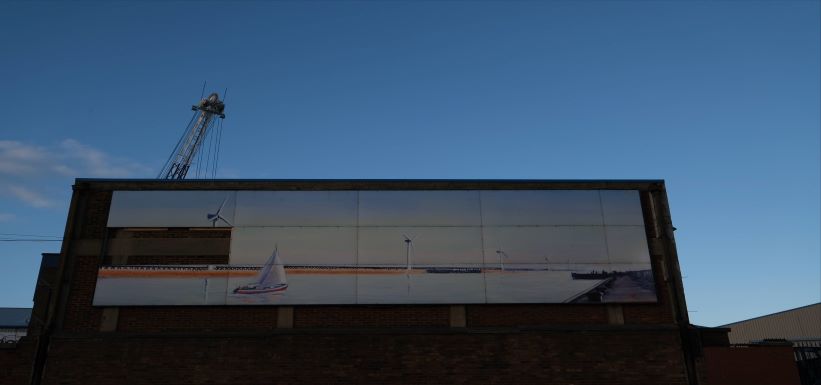Energies: Blyth’s Industrial Pasts and Energy Futures
On behalf of the team: Maia Almeida-Amir, Clifton Evers, Mark Ireland, Greg Mutch, Anthony Zito (PI)
On July 8th, 2021 an interdisciplinary team (cultural studies, geosciences, engineering, public policy) from Newcastle University launched an exhibition at the socially-engaged art space Headway Arts in the Northeast coastal town of Blyth, Northumberland (9 July2021 – 25 July, 2021). Closely working with the local community, multiple community art organisations, archives, industry, and government.
Pilot funding was provided by the One Planet fund and the Institute for Creative Arts Practice at Newcastle University. Interest grew and support from many organisations was gained, including the Shadow Places Network of scholars, artists and activists collaborated through a series of real and virtual encounters to document, co-produce and reimagine connections between places and peoples in an era of climate change.
For the exhibition we commissioned 9 outstanding regionally based artists and sourced archival footage. The exhibition invited the community of the Northeast coastal town of Blyth to share in low-carbon energy industries and the cultural transformations they may bring or already have brought. As part of the exhibit, all visitors were encouraged to share their own thoughts and reactions to Blyth’s energy futures. This was not just an opportunity to speak to each other but to listen together, to nurture shared futures and world-making.
Blyth has a long proud industrial history. It is a key location for the UK government’s decarbonisation plans. There are many promises. Then again, Blyth has borne the brunt of deindustrialisation (particularly of fossil fuel led industries) resulting in very high unemployment, poverty, and concomitant health and wellbeing challenges. While there is hope there are questions. Who benefits? What power do different stakeholders have? Who is accountable to who? Can you say no? What do locals know? What emotions are being felt? How does what happens here connect to ‘over there’? What are the more-than-human considerations? These are urgent ‘just transition’ questions. In academic discourse the ‘just transition’ concept places the rights of workers (both current and past) and communities whose livelihoods depend or depended upon fossil fuels at the center of the climate debate.
The exhibition was the first stage of a project with a creative and participatory ethos at the core, and is aimed at cultivating a wider inclusive discussion about how renewable energy industries are understood and received by local communities with a fossil fuel industrial heritage in the north-east of England. Challenges for these communities include future socio-economic and health well-being, local environmental concerns, and evolving identity given the arrival of new low carbon technologies and industries in their midst (e.g., wind turbines, sea cables, battery gigaplant, biomass power plant, geothermal, carbon capture technologies). We examine how the fossil-free future is imagined by local actors and imbricated in the (re)making of subjects, places, and conditions of life.
Crucially, the creative practice underpins the whole project. We do not view the creative practice as simply communication of research. It is research. Creative practice as research can help people to access and non-verbally express thoughts and feelings, move people to understand and feel place-based experience differently, connect people to institutions in novel ways, better account for more-than-human influence in the making of world(s), and facilitate democratic change through an engaging and empowering participative process. Arts-based research is arguably effective in generating critical and reflexive evaluation of functioning of power, making tacit knowledge available to research, and for speculating about a diversity of futures.
Anna Hickey-Moody (2013, 2016), provides multiple excellent examples of how by proceeding with an idea of creativity understood as an iterative compositional process that cuts across objects, bodies, artefacts, tools, thought, and a particular time and place that can produce an ‘affective pedagogy.’ Hickey-Moody (2016) writes, “aesthetics teach us by changing how we feel” (79) and can re-adjust what a person or institution is or is not able to understand, produce and connect to (261). Creativity as research allow us to not only recognise and appreciate change but transform social, cultural, political, material, and spatial conditions of possibility. In so doing, the potential for alternative future(s) ways of knowing ways of life can occur.
Our hope is to continue to learn from the communities and industries we are working with to further nurture this arguably generative and collectivising research approach.
Dr Clifton Evers is a senior lecturer in cultural studies at Newcastle University. Through participatory and interdisciplinary international research he performs creative practice ethnography with communities and nonhumans about environmental issues, such as polluted leisure, blue spaces, as well as just/inclusive transitions. He is also interested in the intersections of masculinities, sport, and pollution.
